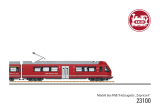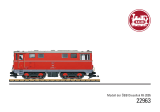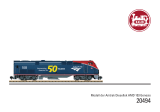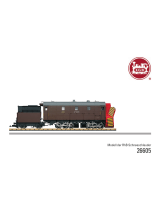
2
Inhaltsverzeichnis: Seite
Informationen zum Vorbild 4
Inbetriebnahme 6
Sicherheitshinweise 10
Wichtige Hinweise 10
Funktionen 10
Schaltbare Funktionen 11
Parameter / Register 12
Betrieb auf der Anlage 34
Wartung und Instandhaltung 36
Ersatzteile 38
Table of Contents: Page
Information about the prototype 4
Putting into Operation 6
Safety Notes 14
Important Notes 14
Functions 14
Controllable Functions 15
Parameter / Register 16
Operation on a layout 34
Service and maintenance 36
Spare parts 38
Sommaire : Page
Informations concernant la locomotive réelle
5
Mise en service 6
Remarques importantes sur la sécurité 18
Information importante 18
Fonctionnement 18
Fonctions commutables 19
Paramètre / Registre 20
Exploitation sur réseau 34
Entretien et maintien 36
Pièces de rechange 38

3
Indice de contenido: Página
Puesta en servicio 7
Aviso de seguridad 26
Notas importantes 26
Funciones 26
Funciones posibles 27
Parámetro / Registro 28
Funcionamiento del sistema 35
El mantenimiento 36
Recambios 38
Inhoudsopgave: Pagina
Informatie van het voorbeeld 5
Ingebruikname 7
Veiligheidsvoorschriften 22
Belangrijke aanwijzing 22
Functies 22
Schakelbare functies 23
Parameter / Register 24
Bedrijf op een modelbaan 35
Onderhoud en handhaving 36
Onderdelen 38
Indice del contenuto: Pagina
Messa in esercizio 7
Avvertenze per la sicurezza 30
Avvertenze importanti 30
Funzioni 30
Funzioni commutabili 31
Parametro / Registro 32
Exploitation sur réseau 35
Manutenzione ed assistere 36
pezzi di ricambio 38

4
Vorbild • Prototype Exploitation dans le réelle • Grootbedrijf
Information about the prototype
In the first decades of the DB, the class E 94 “Crocodiles” formed the
backbone of heavy freight service. Initially, these units could be found
all over the entire (electrified) South German area. With increasing ex-
pansion of electrical operations, their use expanded to Frankfurt/Main.
Starting in 1960, the Crocodiles reached out to the Saarland area and to
the south, they went down to Basle. Naturally, part of their daily work
was pusher service on the steep grades in the Frankenwald region, the
Spessart region, and the Geislingen Grade. Additional electrification in
Northern and Western Germany in the Sixties brought an expansion of
train service to new regions, yet the E 94 units always remained true to
their South German maintenance facilities.
Informationen zum Vorbild
In den ersten Jahrzehnten der DB bildeten die „Krokodile“ der Baurei-
he E 94 das Standbein im schweren Güterverkehr. Zunächst waren die
Maschinen im gesamten (elektrifizierten) süddeutschen Raum zu finden,
wobei mit zunehmender Ausweitung des elektrischen Betriebs Einsätze
bis nach Frankfurt/Main erfolgten. Ab 1960 gelangten die Krokodile bis
ins Saarland und südlich ging es dann bis nach Basel. Zum täglichen Brot
gehörten natürlich auch Schubdienste an den Steilrampen im Franken-
wald, im Spessart und der Geislinger Steige. Weitere Elektrifizierungen in
Nord- und Westdeutschland in den 1960er Jahren brachten eine Auswei-
tung der Zugdienste in neue Gefilde, doch blieben die E 94 immer ihren
süddeutschen Bahnbetriebswerken treu.

5
Vorbild • Prototype Exploitation dans le réelle • Grootbedrijf
Informations concernant la locomotive réelle
Au cours des premières décennies de la DB, les « Crocodiles » de la
série E 94 représentaient le pilier du trafic marchandises lourd. Si les
machines circulèrent d’abord dans tout le sud (électrifié) de l’Alle-
magne, l’expansion croissante de l’exploitation électrique les amena
jusqu’à Francfort/Main. A partir de 1960, les crocodiles arrivèrent
jusque dans la Sarre et au sud jusqu’à Bâle. Les services de pousse
sur les rampes à forte déclivité dans la forêt franconienne, le Spessart
et sur la rampe de Geislingen faisaient naturellement partie des tâches
quotidiennes. L’électrification d’autres lignes dans le nord et l’ouest de
l’Allemagne dans les années 1960 permit l’exploitation des trains dans
de nouveaux paysages, mais les E 94 restèrent toujours fidèles à leurs
dépôts du sud de l’Allemagne.
Informatie van het voorbeeld
Tijdens de eerste decennia van de DB vormde de “krokodil” van de
serie E 94 het standbeen in het zware goederenverkeer. Daarna waren
de machines in het hele (geëlektrificeerde) Zuid-Duitse gebied te
vinden, waarbij de machine met de toenemende uitbreiding van de
elektrische uitbating tot in Frankfurt/Main werd ingezet. Vanaf 1960
gingen de krokodillen tot in Saarland en verder zuidwaarts tot in Basel.
Tot het dagelijkse takenpakket behoorden natuurlijk ook duwdiensten
op de steile hellingen in Frankenwald, in Spessart en de Geislinger
Steige. Verdere elektrificatie in Noord- en West-Duitsland in de jaren
‘60 leidden weliswaar tot een uitbreiding van de treindiensten, maar de
E 94-machines bleven hun Zuid-Duitse depots trouw.

6
Betrieb • Operation • Fonctionnement Exploitatie • Operación • Operazione
Vor dem ersten Betrieb
Dieses Modell ist hinsichtlich der Technik
und der Ausführung besonders aufwändig
und hochwertig. Bitte beachten Sie daher,
dass Sie dieses Modell besonders vorsichtig
handhaben sollten.
Für Reparaturen oder den Tausch von Teilen
wenden Sie sich bitte an den Märklin Service.
Hinweise
• Die Dachstromabnehmer werden über Mo-
toren angetrieben. Sie dürfen niemals von
Hand ausgefahren werden, können aber
z.B. zum Verpacken des Modells von Hand
eingefahren werden.
• Im Analogbetrieb sind beide Strohmabneh-
mer eingefahren.
• Die Stromabnehmer können eingerastet
werden. Wir empfehlen die Stromabnehmer
vor dem Ausrasten auszufahren.
Before Operating for the First Time
This model is especially complex and costly
in terms of its technology. Please therefore
note that you should handle this model with
special care.
Please contact Märklin Service for replace-
ment of parts or for repairs.
Notes
• The pantographs are powered by motors.
They must never be raised by hand, but
they can be lowered by hand to be put back
in the packaging for the model.
• Both pantographs are lowered in analog
operation.
• The pantographs can be latched in place.
We recommend raising the pantographs
before unlatching them.
Avant la première mise en service
Ce modèle bénéficie d’une technicité de
haut niveau et d‘une finition particulièrement
soignée. Veillez donc à manipuler ce modèle
avec un soin particulier.
Pour les pièces détaillées ou d’éventuelles
réparations, veuillez vous adresser au Service
Märklin.
Remarques
• Les pantographes sont entraînés via des
moteurs. S’ils ne doivent en aucun cas être
levés manuellement, ils peuvent par contre
être baissés manuellement, par exemple
pour emballer le modèle.
• En mode d’exploitation analogique, les deux
pantographes sont baissés.
• Les pantographes peuvent être verrouillés.
Nous conseillons de lever les pantographes
avant le déverrouillage.

7
Betrieb • Operation • Fonctionnement Exploitatie • Operación • Operazione
Voor het eerste gebruik
Dit model is vanwege de techniek en de uit-
voering bijzonder uitgewerkt en hoogwaardig
uitgevoerd. Let er daarom op dat u het model
uitermate voorzichtig behandelt.
Voor het vervangen van delen of reparaties
kunt u zich wenden tot het Märklin service
centrum.
Aanwijzingen
• De pantografen worden met motoren
aangedreven . Deze mogen nooit handma-
tig omhoog gebracht worden, ze kunnen
echter wel handmatig naar beneden gela-
ten worden bijv. voor het verpakken van het
model.
• In analoog bedrijf zijn beide pantografen
naar beneden gelaten.
• De pantografen kunnen vastgeklikt worden.
Het is aan te bevelen de pantografen voor
het losklikken omhoog te laten m.b.v. de
besturing.
Antes de la primera puesta en servicio
En los aspectos de tecnología incorporada y
ejecución, este modelo en miniatura es muy
sofisticado y avanzado. Por este motivo, tenga
presente que debe manejar este modelo con
suma precaución.
Para la sustitución de piezas o para reparaci-
ones, diríjase al Servicio de Märklin.
Consejos
• Los pantógrafos son accionados por
motores. Nunca despliegue los pantógrafos
manualmente, si bien puede replegarlos
manualmente, p. ej., para embalar el mode-
lo en miniatura.
• En funcionamiento en modo analógico,
ambos pantógrafos están replegados.
• Los pantógrafos pueden enclavarse. Reco-
mendamos desplegar los pantógrafos antes
de desenclavarlos.
Prima del primo funzionamento
Questo modello è particolarmente complicato
e di alto pregio sotto l’aspetto della tecnologia
e dell’esecuzione. Vogliate pertanto prestare
attenzione, affinché Voi maneggiate questo
modello con particolare cautela.
Per la sostituzione di componenti oppure
riparazioni, vogliate rivolgerVi al Servizio
Assistenza Märklin.
Avvertenza
• I pantogra sul tetto vengono azionati tra-
mite dei motori. Essi non devono mai venire
sollevati a mano, tuttavia possono venire
abbassati a mano ad es. per l’imballaggio di
tale modello.
• Nell’esercizio analogico entrambi i panto-
grafi sono abbassati.
• Tali pantogra possono venire bloccati in
basso. Noi consigliamo prima dello sblocco
di fare alzare i pantografi.

8
Betrieb • Operation • Fonctionnement Exploitatie • Operación • Operazione
Aus Sicherheitsgründen ist dieses schwere
Modell auf einem Sockel angeschraubt.
Bitte transportieren Sie die Lokomotive nur
auf diesem Sockel gesichert in der zugehö-
rigen Originalkassette.
This heavy model is screwed to a base for
safety reasons.
Please make sure this powered rail car is
secured on this base in its original packaging
when transporting it.
Vanwege de veiligheid is dit zware model op
een sokkel vastgeschroefd.
Transporteer de loc a.u.b. alleen vastgeschro-
efd op de sokkel in de bijbehorende originele
cassette.
Pour des raisons de sécurité, ce modèle lourd
est vissé sur un socle.
Prenez soin de transporter cette locomotive
uniquement sécurisée sur ce socle et dans sa
boîte d’origine.
Per ragioni di sicurezza questo pesante mo-
dello è avvitato sopra un suo basamento.
Si prega di trasportare tale locomotiva
soltanto fissata su questo basamento nella
corrispondente cassetta originale.
Por motivos de seguridad, este pesado mode-
lo en miniatura se entrega atornillado sobre
un zócalo.
Transporte la locomotora siempre inmoviliz-
ada sobre este zócalo en la casete original
asociada.

9
Betrieb • Operation • Fonctionnement Exploitatie • Operación • Operazione
• Der Dachstromabnehmer wird über einen
Servo-Motoren angetrieben. Er darf nie-
mals von Hand ausgefahren werden, kann
aber z.B. zum Verpacken des Modells von
Hand eingefahren werden.
• The pantograph is powered by a servo-
motor. It must never be raised by hand. It
can be lowered by hand for things such as
packing the model.
• Le pantographe est entraîné par un servo-
moteur. S’il ne doit en aucun cas être
levé manuellement, il peut par contre être
baissé manuellement, par exemple pour
emballer le modèle.
• De pantograaf wordt aangedreven door
een servo-motor. Hij mag nooit handmatig
omhoog gehaald worden maar kan voor het
verpakken van het model wel handmatig
neergelaten worden.
• El pantógrafo es accionado por un servo-
motor. Nunca está permitido desplegarlo
manualmente, pero, por ejemplo, se puede
replegar manualmente para embalar el
modelo.
• Il pantografo sul tetto viene azionato medi-
ante un servo-motore. Esso non deve mai
venire sollevato a mano, tuttavia può venire
abbassato a mano ad es. per l’imballaggio
del modello.

10
Betrieb • Operation • Fonctionnement Exploitatie • Operación • Operazione
Sicherheitshinweise
• Die Lok darf nur mit einem dafür bestimmten Betriebssystem
(Gleichstrom [DC] = max 18V±, Märklin Wechselstrom,
Märklin Digital, Märklin Systems oder DCC) eingesetzt werden.
• Nur Schaltnetzteile/Transformatoren verwenden, die Ihrer örtlichen
Netzspannung entsprechen.
• Die Lok darf nur aus einer Leistungsquelle versorgt werden.
• Beachten Sie unbedingt die Sicherheitshinweise in der Bedienungs-
anleitung zu Ihrem Betriebssystem.
• Für den konventionellen Betrieb der Lok muss das Anschlussgleis
entstört werden. Dazu ist das Entstörset 104770 zu verwenden. Für
Digitalbetrieb ist das Entstörset nicht geeignet.
• Das verwendete Gleisanschlusskabel darf maximal 2 Meter lang sein.
• Setzen Sie das Modell keiner direkten Sonneneinstrahlung, starken
Temperaturschwankungen oder hoher Luftfeuchtigkeit aus.
• ACHTUNG! Funktionsbedingte scharfe Kanten und Spitzen.
• Verbaute LED`s entsprechen der Laserklasse 1 nach Norm EN 60825-1.
Wichtige Hinweise
• Wegen der hohen Leistungsaufnahme dieser Lokomotive ist der Be-
trieb mit der Mobile Station 60652/60653 nur eingeschränkt möglich.
• Die Bedienungsanleitung ist Bestandteil des Produktes und muss
deshalb aufbewahrt sowie bei Weitergabe des Produktes mitgege-
ben werden.
• Für Reparaturen oder Ersatzteile wenden Sie sich bitte an Ihren
Märklin-Fachhändler.
•
Gewährleistung und Garantie gemäß der beiliegenden Garantieurkunde.
• Entsorgung: www.maerklin.com/en/imprint.html
Funktionen
•
Die Betriebsart (AC/DC, Mfx, Märklin-Motorola oder DCC) wird
automatisch erkannt.
• Einstellbare Adressen:
1-80 (Control Unit 6021)
1-255 (Central Station 6021x)
01 – 10239 DCC
• Adresse ab Werk: (Märklin) 23 + 24 / (DCC) 3
• Mfx-Technologie für Mobile Station / Central Station.
Name ab Werk: 94 062
• Einstellen der Lokparameter (Adresse, Anfahr-/Bremsverzögerung,
Höchstgeschwindigkeit usw.): mit Control Unit und DCC (CV Pro-
grammierung), Mobile Station oder Central Station.
• Fahrtrichtungsabhängige Stirnbeleuchtung.
• Das Modell ist für den Betrieb auf Märklin 1-Gleisen entwickelt. Ein
Betrieb auf anderen Gleissystemen geschieht auf eigenes Risiko.
• Befahrbarer Mindestradius: 1020 mm
• Die Lok ist nicht auf Oberleitungsbetrieb umschaltbar.
• Im Analogbetrieb stehen nur die Fahr- und Lichtwechselfunktionen
zur Verfügung.
Hinweis:
Die Steckbrücke (siehe Seite 37) muss zum Programmieren unter DCC
abgezogen sein.

11
Betrieb • Operation • Fonctionnement Exploitatie • Operación • Operazione
Schaltbare Funktionen
Digital/Systems
Spitzensignal function/off Funktion f0
Führerstandsbeleuchtung f1 Funktion f1 AUX 1
Geräusch: Betriebsgeräusch f2 Funktion f2
Geräusch: Pfeife f3 Funktion f3 Sound 1
ABV, aus f4 Funktion f4
Geräusch: Lüfter — Funktion f5 Sound 9
Rangierlicht — Funktion f6 AUX 2
Pantograph 1 heben/senken — Funktion f7 Sound 15 & AUX 4
Geräusch: Bremsenquietschen aus — Funktion f8
Pantograph 2 heben/senken — Funktion f9 Sound 16 & AUX 3
Anfahrlicht — Funktion f10 AUX 5 & AUX 6
Geräusch: Ankuppeln — Funktion f11 Sound 13
Geräusch: Sanden — Funktion f12 Sound 14
Geräusch: Bahnhofsansage — Funktion f13 Sound 4
Geräusch: Rangierpff — Funktion f14 Sound 3
Geräusch: Entfroster — Funktion f15 Sound 10
f0 f8 f0f8

12
Betrieb • Operation • Fonctionnement Exploitatie • Operación • Operazione
CV Bedeutung Wert für 6021 Wert DCC
01 Adresse 01 – 80 (1 + 2) 1 – 127 (3)
CV 29/Bit 5 =0
02 PoM Minimalgeschwindigkeit — 0 – 255 (25)
03 PoM Anfahrverzögerung 01 – 63 0 – 255 (15)
04 PoM Bremsverzögerung 01 – 63 0 – 255 (15)
05 PoM Maximalgeschwindigkeit 01 – 63 0 – 255 (245)
08 Werkreset/Herstellerkennung 08 08 (131)
13 PoM Funktionen F1 - F8 im Analogbetrieb — 0 – 255 (0)
14 PoM Funktionen F9 - F15 und Licht im Analogbetrieb — 0 – 255 (1)
17 Erweiterte Adresse (oberer Teil CV29 Bit 5 =1) — 192 – 255 (192)
18 Erweiterte Adresse (unterer Teil CV29 Bit 5 =1) — 0 – 255 (128)
19 Traktionsadresse — 0 – 255 (0)
21 PoM Funktionen F1 - F8 bei Traktion — 0 – 255 (0)
22 PoM Funktionen F9 - F15 und Licht bei Traktion — 0 – 255 (0)
29
Bit 0: Umpolung Fahrtrichtung
Bit 1: Anzahl Fahrstufen 14 oder 28/128
Bit 2: DCC Betrieb mit Bremsstrecke
Bit 5: Adressumfang 7 Bit / 14 Bit
—
0 / 1 (0)*
0 / 2 (2)*
0 / 4 (4)*
0 / 32 (0)*
60 PoM
Multibahnhofsansage
Bit 0 – 3 = Anzahl der Bahnhöfe
Bit 4 = letzter Bahnhof kehrt Reihenfolge um
Bit 5 = Lokrichtung bestimmt Reihenfolge
Bit 6 = Reihenfolge Grundeinstellung
— 0 – 127 (0)
63 PoM Lautstärke 01 - 63 (63) 0 – 255 (255)
138 PoM Lautstärke Sound „Bremsenquietschen“ — 0 – 255 (255)
139 PoM Lautstärke Sound „Betriebsgeräusch“ — 0 – 255 (255)
140 PoM Lautstärke Sound 1 (Pfeife) — 0 – 255 (255)

13
CV Bedeutung Wert für 6021 Wert DCC
142 PoM Lautstärke Sound 3 (Rangierpfiff) — 0 – 255 (255)
143 PoM Lautstärke Sound 4 (Bahnhofsansage) — 0 – 255 (255)
148 PoM Lautstärke Sound 9 (Lüfter) — 0 – 255 (255)
149 PoM Lautstärke Sound 10 (Entfroster) — 0 – 255 (255)
152 PoM Lautstärke Sound 13 (Ankuppeln) — 0 – 255 (255)
153 PoM Lautstärke Sound 14 (Sanden) — 0 – 255 (255)
154 PoM Lautstärke Sound 15 (Pantograph) — 0 – 255 (255)
155 PoM Lautstärke Sound 16 (Pantograph) — 0 – 255 (255)

14
Betrieb • Operation • Fonctionnement Exploitatie • Operación • Operazione
Functions
• The mode of operation (AC/DC, Mfx, Märklin Motorola, or DCC) is
recognized automatically.
• Possible addresses:
1-80 (Control Unit 6021)
1-255 (Central Station 6021x)
01 – 10239 DCC
• Address set at the factory: (Märklin) 23 + 24 / (DCC) 3
• Mfx technology for the Mobile Station / Central Station.
Name set at the factory: 94 062
• Setting locomotive parameters (address, acceleration/braking delay,
maximum speed, etc.): with the Control Unit and DCC (CV program-
ming), Mobile Station, or the Central Station.
• Headlights, changing over with the direction of travel.
• The model is designed for operation on Märklin 1 Gauge track. As
the consumer you assume the risk for operating on other makes of
track.
• Minimum radius for operation: 1020 mm / 40-1/6“.
• The locomotive cannot be switched to operation from catenary.
• Only the train control functions and headlight changeover feature
are available in analog operation.
Note:
The bridge plug (see Page 37) must be pulled out for programming
under DCC.
Safety Notes
• This locomotive is to be used only with an operating system desi-
gned for it (DC power = 18V±, Märklin AC, Märklin Digital,
Märklin Systems, DCC).
• Use only switched mode power supply units and transformers that
are designed for your local power system.
• This locomotive must never be supplied with power from more than
one transformer.
• Pay close attention to the safety notes in the instructions for your
operating system.
• The feeder track must be equipped to prevent interference with
radio and television reception, when the locomotive is to be run in
conventional operation. The 104770 interference suppression set is
to be used for this purpose.
• The wire used for feeder connections to the track may only be a
maximum of 2 meters / 78 inches long.
• Do not expose the model to direct sunlight, extreme changes in
temperature, or high humidity.
• WARNING! Sharp edges and points required for operation.
• The LEDs in this item correspond to Laser Class 1 according to Stan-
dard EN 60825-1.
Important Notes
• Due to the high power requirements for this heavy locomotive, there
are only limited possibilities for operation with the
60652/60653
Mobile Station.
• The operating instructions are a component part of the product and must
therefore be kept as well as transferred along with the product to others.
• Please see your authorized Märklin dealer for repairs or spare parts.
• The warranty card included with this product species the warranty
conditions.
• Disposing: www.maerklin.com/en/imprint.html

15
Betrieb • Operation • Fonctionnement Exploitatie • Operación • Operazione
Controllable Functions
Digital/Systems
Headlights function/off Function f0
Engineer‘s cab lighting f1 Function f1 AUX 1
Sound effect: Operating sounds f2 Function f2
Sound effect: Whistle blast f3 Function f3 Sound 1
ABV, off f4 Function f4
Sound effect: Blower — Function f5 Sound 9
switching light — Function f6 AUX 2
Pantograph 1 raise/lower — Function f7 Sound 15 & AUX 4
Sound effect: Squealing brakes off — Function f8
Pantograph 2 raise/lower — Function f9 Sound 16 & AUX 3
Approach light — Function f10 AUX 5 & AUX 6
Sound effect: Coupling together — Function f11 Sound 13
Sound effect: Sanding — Function f12 Sound 14
Sound effect: Station announcements — Function f13 Sound 4
Sound effect: Switching whistle — Function f14 Sound 3
Sound effect: defroster — Function f15 Sound 10
f0 f8 f0f8

16
Betrieb • Operation • Fonctionnement Exploitatie • Operación • Operazione
CV Discription 6021 Value DCC Value
01 Address 01 – 80 (1 + 2) 1 – 127 (3)
CV 29/Bit 5 =0
02 PoM Minimum Speed — 0 – 255 (25)
03 PoM Acceleration delay 01 – 63 0 – 255 (15)
04 PoM Braking delay 01 – 63 0 – 255 (15)
05 PoM Maximum speed 01 – 63 0 – 255 (245)
08 Factory Reset / Manufacturer Recognition 08 08 (131)
13 PoM Functions F1 - F8 in analog operation — 0 – 255 (0)
14 PoM Functions F9 - F15 and lights in analog operation — 0 – 255 (1)
17 Extended address (upper part CV29 Bit 5 = 1) — 192 – 255 (192)
18 Extended address (lower part CV29 Bit 5 = 1) — 0 – 255 (128)
19 Multiple Unit Address — 0 – 255 (0)
21 PoM Functions F1 - F8 on Multiple Unit — 0 – 255 (0)
22 PoM Functions F9 - F15 and lights on Multiple Unit — 0 – 255 (0)
29
Bit 0: Reversing direction
Bit 1: Number of speed levels 14 or 28/128
Bit 2: DCC operation with braking area
Bit 5: Address length 7 Bit / 14 Bit
—
0 / 1 (0)*
0 / 2 (2)*
0 / 4 (4)*
0 / 32 (0)*
60 PoM
Multiple station announcements
Bit 0 – 3 = Number of stations
Bit 4 = Last station reverses the sequence.
Bit 5 = Locomotive direction determines the sequence.
Bit 6 = Basic setting for sequence.
— 0 – 127 (0)
63 PoM Volume 01 - 63 (63) 0 – 255 (255)
138 PoM Volume for sound "squealing brakes" — 0 – 255 (255)
139 PoM Volume for sound "operating sounds" — 0 – 255 (255)
140 PoM Volume for sound 1 (whistle) — 0 – 255 (255)
( ) Values = factory settings
DCC: programming on the programming track by means of CV programming,
programming with PoM (Program on the Main); this must be supported by the controller you are using.
* The values for the desired setting must be added!
Example: The number of speed levels 28/128 = 2 + DCC operation with a braking route = 4, results in the value = 6

17
CV Discription 6021 Value DCC Value
142 PoM Volume for sound 3 (Switching whistle) — 0 – 255 (255)
143 PoM Volume for sound 4 (Station announcements) — 0 – 255 (255)
148 PoM Volume for sound 9 (lower ) — 0 – 255 (255)
149 PoM Volume for sound 10 (defroster) — 0 – 255 (255)
152 PoM Volume for sound 13 (Coupling together) — 0 – 255 (255)
153 PoM Volume for sound 14 (Sanding) — 0 – 255 (255)
154 PoM Volume for sound 15 (Pantograph) — 0 – 255 (255)
155 PoM Volume for sound 16 (Pantograph) — 0 – 255 (255)

18
Betrieb • Operation • Fonctionnement Exploitatie • Operación • Operazione
Remarques importantes sur la sécurité
• La locomotive ne peut être mise en service qu’avec un système
d’exploitation adéquat (DC = 18V ±, Märklin AC, Märklin Digital,
Märklin Systems ou DCC).
• Utiliser uniquement des convertisseurs et transformateurs corre-
spondant à la tension du secteur local.
• La locomotive ne peut être alimentée en courant que par une seule
source de courant.
• Veuillez impérativement respecter les remarques sur la sécurité
décrites dans le mode d’emploi de votre système d’exploitation.
• Pour l’exploitation de la locomotive en mode conventionnel, la voie
de raccordement doit être déparasitée. A cet effet, utiliser le set de
déparasitage réf. 104770. Le set de déparasitage ne convient pas
pour l’exploitation en mode numérique.
• Le câble de raccordement à la voie utilisé ne doit en aucun cas
dépasser deux mètres.
• Ne pas exposer le modèle à un ensoleillement direct, à de fortes
variations de température ou à un taux d‘humidité important.
• ATTENTION! Pointes et bords coupants lors du fonctionnement du
produit.
• Les DEL installées correspondent à la classe laser 1 selon la norme
EN 60825-1.
Information importante
• Du fait de l’importance de la puissance absorbée de cette locomotive,
l’exploitation avec la Mobile Station
60652/60653
n’est possible que dans
certaines limites.
• La notice d‘utilisation font partie intégrante du produit ; ils doivent donc
être conservés et, le cas échéant, transmis avec le produit.
• Pour toute réparation ou remplacement de pièces, adresses-vous à
votre détaillant-spécialiste Märklin.
• Garantie légale et garantie contractuelle conformément au certicat
de garantie ci-joint.
• Elimination : www.maerklin.com/en/imprint.html
Fonctionnement
• Le mode d’exploitation (AC/DC, Mfx, Märklin-Motorola ou DCC) est
identifié automatiquement.
• Adresses pouvant être paramétrées :
1-80 (Control Unit 6021)
1-255 (Central Station 6021x)
01 – 10239 DCC
• Adresse départ usine : (Märklin) 23 + 24 / (DCC) 3
• Technologie mfx pour Mobile Station / Central Station.
Nom encodée en usine : 94 062
• Paramétrer les paramètres des locomotives (adresse, retardement
au démarrage / au freinage, vitesse maximale etc.) avec Control Unit
et DCC (programmation CV), Mobile Station ou Central Station.
• Feux de signalisation avec inversion selon sens de marche.
• Le modèle réduit est conçu pour rouler sur des voies Märklin 1. Le
faire rouler sur des voies d’autres systèmes comporte des risques.
• Rayon minimal d’inscription en courbe: 1020 mm.
• La locomotive ne peut pas être exploitée sous caténaire.
• En mode d’exploitation analogique, seules les fonctions relatives à la
conduite et à l‘inversion des feux sont disponibles.
Remarque :
Le fil jarretière (voir page 37) doit être retiré pour la programmation
sous DCC.

19
Betrieb • Operation • Fonctionnement Exploitatie • Operación • Operazione
Fonctions commutables
Digital/Systems
Fanal function/off Fonction f0
Eclairage de la cabine de conduite f1 Fonction f1 AUX 1
Bruitage : Bruit d’exploitation f2 Fonction f2
Bruitage : sifet f3 Fonction f3 Sound 1
ABV, désactivé f4 Fonction f4
Bruitage : ventilateur — Fonction f5 Sound 9
Feu de manœuvre — Fonction f6 AUX 2
Pantographe 1 (relever/abaisser) — Fonction f7 Sound 15 & AUX 4
Bruitage : Grincement de freins désactivé — Fonction f8
Pantographe 2 (relever/abaisser) — Fonction f9 Sound 16 & AUX 3
Feu de démarrage — Fonction f10 AUX 5 & AUX 6
Bruitage : Attelage — Fonction f11 Sound 13
Bruitage : Sablage — Fonction f12 Sound 14
Bruitage : Annonce en gare — Fonction f13 Sound 4
Bruitage : Sifet pour manœuvre — Fonction f14 Sound 3
Bruitage : dégivreur — Fonction f15 Sound 10
f0 f8 f0f8

20
Betrieb • Operation • Fonctionnement Exploitatie • Operación • Operazione
CV Affectation 6021 Valeur DCC Valeur
01 Adresse 01 – 80 (1 + 2) 1 – 127 (3)
CV 29/Bit 5 =0
02 PoM Vitesse minimale — 0 – 255 (25)
03 PoM Temporisation d‘accélération 01 – 63 0 – 255 (15)
04 PoM Temporisation de freinage 01 – 63 0 – 255 (15)
05 PoM Vitesse maximale 01 – 63 0 – 255 (245)
08 Réinitialisation d’usine/identification du fabricant 08 08 (131)
13 PoM Fonctions F1 - F8 en mode analogique — 0 – 255 (0)
14 PoM Fonctions F9 - F15 et éclairage en mode analogique — 0 – 255 (1)
17 Adresse étendue (partie supérieure CV29 Bit 5 = 1) — 192 – 255 (192)
18 Adresse étendue (partie inférieure CV29 Bit 5 = 1) — 0 – 255 (128)
19 Adresse traction — 0 – 255 (0)
21 PoM Fonctions F1 - F8 pour traction — 0 – 255 (0)
22 PoM Fonctions F9 - F15 et éclairage traction — 0 – 255 (0)
29
Bit 0: Inv. polarité Sens de marche
Bit 1: Nombre de crans de marche 14 ou 28/128
Bit 2:
Mode DCC avec dist. de freinage (pas possible en mode
analogique)
Bit 5: Capacité d’adresses 7 Bit / 14 Bit
—
0 / 1 (0)*
0 / 2 (2)*
0 / 4 (4)*
0 / 32 (0)*
60 PoM
Annonce multi-gares
Bit 0 – 3 = nombre de gares
Bit 4 = la dernière gare inverse l’ordre
Bit 5 = la direction de la locomotive détermine l’ordre
Bit 6 = ordre du paramétrage de base
— 0 – 127 (0)
63 PoM Volume 01 - 63 (63) 0 – 255 (255)
138 PoM Volume Sound « Grincement des freins » — 0 – 255 (255)
139 PoM Volume Sound « Bruit de fonctionnement » — 0 – 255 (255)
La pagina si sta caricando...
La pagina si sta caricando...
La pagina si sta caricando...
La pagina si sta caricando...
La pagina si sta caricando...
La pagina si sta caricando...
La pagina si sta caricando...
La pagina si sta caricando...
La pagina si sta caricando...
La pagina si sta caricando...
La pagina si sta caricando...
La pagina si sta caricando...
La pagina si sta caricando...
La pagina si sta caricando...
La pagina si sta caricando...
La pagina si sta caricando...
La pagina si sta caricando...
La pagina si sta caricando...
La pagina si sta caricando...
La pagina si sta caricando...
-
 1
1
-
 2
2
-
 3
3
-
 4
4
-
 5
5
-
 6
6
-
 7
7
-
 8
8
-
 9
9
-
 10
10
-
 11
11
-
 12
12
-
 13
13
-
 14
14
-
 15
15
-
 16
16
-
 17
17
-
 18
18
-
 19
19
-
 20
20
-
 21
21
-
 22
22
-
 23
23
-
 24
24
-
 25
25
-
 26
26
-
 27
27
-
 28
28
-
 29
29
-
 30
30
-
 31
31
-
 32
32
-
 33
33
-
 34
34
-
 35
35
-
 36
36
-
 37
37
-
 38
38
-
 39
39
-
 40
40
in altre lingue
- français: Märklin 55223 Manuel utilisateur
- español: Märklin 55223 Manual de usuario
- Deutsch: Märklin 55223 Benutzerhandbuch
- Nederlands: Märklin 55223 Handleiding
Documenti correlati
Altri documenti
-
 LGB 23100 Istruzioni per l'uso
LGB 23100 Istruzioni per l'uso
-
 LGB 22963 Istruzioni per l'uso
LGB 22963 Istruzioni per l'uso
-
FLEISCHMANN 413673 Istruzioni per l'uso
-
 LGB 20494 Istruzioni per l'uso
LGB 20494 Istruzioni per l'uso
-
 LGB 26605 Instructions Manual
LGB 26605 Instructions Manual
-
 LGB 55029 Manuale del proprietario
LGB 55029 Manuale del proprietario
-
Viessmann 2625 Manuale del proprietario
-
Viessmann 2624 Manuale del proprietario
-
Viessmann 5232 Manuale del proprietario
-
Hornby Railmaster Istruzioni per l'uso













































